Sound Analysis to Predict the Growth of Turkeys
Simple Summary
Abstract
1. Introduction
2. Materials and Methods
2.1. Study Location and Ethics
2.2. Bird Management
2.3. Data Collection
2.4. Sound Analysis
2.5. Data Processing
2.5.1. Estimation of the Relationships among Age, Bird Weight and PF in Each Trial
2.5.2. Estimation of the Relationships among Age, Weight and PF Based on Pooled Data
2.5.3. Definition and Validation of a Model to Predict Turkeys’ Weight Using the PF of Their Vocalizations
3. Results
3.1. Estimated Relationships among Age, Bird Weight and PF in Each Trial
3.2. Estimated Relationships among Age, Weight and PF Based on Pooled Data
3.3. Calibration and Validation of a Model to Predict the Weight of Turkeys Using the PF of Their Vocalizations
4. Discussion
4.1. Weight-Age Relationship
4.2. Weight-Sound Relationship
5. Conclusions
Supplementary Materials
Author Contributions
Funding
Acknowledgments
Conflicts of Interest
References
- Cao, Y.; Li, D. Impact of increased demand for animal protein products in Asian countries: Implications on global food security. Anim. Front. 2013, 3, 48–55. [Google Scholar] [CrossRef]
- Tullo, E.; Fontana, I.; Guarino, M. Precision livestock farming: An overview of image and sound labelling. In Proceedings of the 6th European Conference on Precision Livestock Farming, Leuven, Belgium, 10–12 September 2013; pp. 30–38. [Google Scholar]
- FAO. FAO Statistical Database. 2018. Available online: http://www.fao.org/faostat/en/#data/QL/metadata (accessed on 20 February 2020).
- Yilmaz, O.; Denk, H.; Kucuk, M. Growth performance and mortality in Hybrid Converter turkeys reared at high altitude region. Bulg. J. Agric. Sci. 2011, 17, 241–245. [Google Scholar]
- Krautwald-Junghanns, M.-E.; Ellerich, R.; Mitterer-Istyagin, H.; Ludewig, M.; Fehlhaber, K.; Schuster, E.; Berk, J.; Petermann, S.; Bartels, T. Examinations on the prevalence of footpad lesions and breast skin lesions in British united turkeys big 6 fattening turkeys in Germany. Part I: Prevalence of footpad lesions. Poult. Sci. 2011, 90, 555–560. [Google Scholar] [CrossRef] [PubMed]
- Beaulac, K.; Schwean-Lardner, K. Assessing the effects of stocking density on turkey tom health and welfare to 16 weeks of age. Front. Vet. Sci. 2018, 5, 213. [Google Scholar] [CrossRef]
- Tariq, M.M.; Iqbal, F.; Eyduran, E.; Bajwa, M.A.; Huma, Z.E.; Waheed, A. Comparison of non-linear functions to describe the growth in Mengali sheep breed of Balochistan. Pak. J. Zool. 2013, 45, 661–665. [Google Scholar]
- Sogut, B.; Celik, S.; Ayasan, T.; Inci, H. Analyzing growth curves of turkeys reared in different breeding systems (intensive and free-range) with some nonlinear models. Braz. J. Poult. Sci. 2016, 18, 619–628. [Google Scholar] [CrossRef]
- Kramer, K.; Kinter, L.B. Evaluation and applications of radiotelemetry in small laboratory animals. Physiol. Genom. 2003, 13, 197–205. [Google Scholar] [CrossRef]
- Mollah, M.B.R.; Hasan, M.A.; Salam, M.A.; Ali, M.A. Digital image analysis to estimate the live weight of broiler. Comput. Electron. Agric. 2010, 72, 48–52. [Google Scholar] [CrossRef]
- Krause, J.; Krause, S.; Arlinghaus, R.; Psorakis, I.; Roberts, S.; Rutz, C. Reality mining of animal social systems. Trends Ecol. Evol. 2013, 28, 541–551. [Google Scholar] [CrossRef]
- Kays, R.; Crofoot, M.C.; Jetz, W.; Wikelski, M. Terrestrial animal tracking as an eye on life and planet. Science 2015, 348. [Google Scholar] [CrossRef]
- Blumstein, D.T.; Mennill, D.J.; Clemins, P.; Girod, L.; Yao, K.; Patricelli, G. Acoustic monitoring in terrestrial environments using microphone arrays: Applications, technological considerations and prospectus. J. Appl. Ecol. 2011, 48, 758–767. [Google Scholar] [CrossRef]
- Ferrante, V.; Lolli, S.; Ferrari, L.; Watanabe, T.T.N.; Tremolada, C.; Marchewka, J.; Estevez, I. Differences in prevalence of welfare indicators in male and female turkey flocks (Meleagris gallopavo). Poult. Sci. 2019, 98, 1568–1574. [Google Scholar] [CrossRef] [PubMed]
- Pérez-Granados, C.; Bota, G.; Giralt, D.; Barrero, A.; Gómez-Catasús, J.; La Rosa, D.B.; Traba, J. Vocal activity rate index: A useful method to infer terrestrial bird abundance with acoustic monitoring. Ibis 2019, 161, 901–907. [Google Scholar] [CrossRef]
- Liu, L.; Ni, J.; Li, Y.; Erasmus, M.; Stevenson, R.; Shen, M. Assessment of heat stress in turkeys using animal vocalization analysis. In Proceedings of the American Society of Agricultural and Biological Engineers (ASABE) Meeting Presentation, Detroit, MI, USA, 29 July–1 August 2018. Paper Number 1801743. [Google Scholar] [CrossRef]
- Fontana, I.; Tullo, E.; Butterworth, A.; Guarino, M. An innovative approach to predict the growth in intensive poultry farming. Comput. Electron. Agric. 2015, 119, 178–183. [Google Scholar] [CrossRef]
- Fontana, I.; Tullo, E.; Carpentier, L.; Berckmans, D.; Butterworth, A.; Vranken, E.; Norton, T.; Berckmans, D.; Guarino, M. Sound analysis to model weight of broiler. Poult. Sci. 2017, 96, 3938–3943. [Google Scholar] [CrossRef] [PubMed]
- Marchewka, J.; Estevez, G.; Vezzoli, V.F.; Makagon, M.M. The transect method: A novel approach to on-farm welfare assessment of commercial turkeys. Poult. Sci. 2015, 94, 7–16. [Google Scholar] [CrossRef]
- Ferrari, S.; Silva, M.; Guarino, M.; Aerts, J.M.; Berckmans, D. Cough sound analysis to identify respiratory infection in pigs. Comput. Electron. Agric. 2008, 64, 318–325. [Google Scholar] [CrossRef]
- Van Liew, M.W.; Arnold, J.G.; Garbrecht, J.D. Hydrologic simulation on agricultural watersheds: Choosing between two models. Trans. ASABE 2003, 46, 1539–1551. [Google Scholar] [CrossRef]
- Moriasi, D.N.; Arnold, J.G.; Van Liew, M.W.; Bingner, R.L.; Harmel, R.D.; Veith, T.L. Model evaluation guidelines for systematic quantification of accuracy in watershed simulations. Trans. ASABE 2007, 50, 885–900. [Google Scholar] [CrossRef]
- Ritter, A.; Muñoz-Carpena, R. Performance evaluation of hydrological models: Statistical significance for reducing subjectivity in goodness-of-fit assessments. J. Hydrol. 2013, 480, 33–45. [Google Scholar] [CrossRef]
- Lorenzo, T.; Levi, W.; Curtis, H.; Giovanni, P. Bayesian nonparametric cross-study validation of prediction methods. Ann. Appl. Stat. 2015, 9, 402–428. [Google Scholar] [CrossRef]
- Eleroglu, H.; Yıldırım, A.; Şekeroğlu, A.; Çoksöyler, F.N.; Duman, M. Comparison of growth curves by growth models in slow-growing chicken genotypes raised the organic system. Int. J. Agric. Biol. 2014, 16, 529–535. [Google Scholar]
- Rizzi, C.; Contiero, B.; Casandro, M. Growth patterns of Italian local chicken populations. Poult. Sci. 2013, 92, 2226–2235. [Google Scholar] [CrossRef] [PubMed]
- Elemans, C.P.H.; Heeck, K.; Muller, M. Spectrogram analysis of animal sound production. Bioacoustics 2008, 18, 183–212. [Google Scholar] [CrossRef]
- Mcloughlin, M.P.; Stewart, R.; McElligott, A.G. Automated bioacoustics: Methods in ecology and conservation and their potential for animal welfare monitoring. J. R. Soc. Interface 2019, 16, 20190225. [Google Scholar] [CrossRef]
- Gerhardt, H.C.; Huber, F.; Simmons, A.M. Acoustic communication in insects and anurans: Common problems and diverse solutions. J. Acoust. Soc. Am. 2003, 114, 671–772. [Google Scholar] [CrossRef]
- Zollinger, S.A.; Podos, J.; Nemeth, E.; Goller, F.; Brumma, H. On the relationship between, and measurement of, amplitude and frequency in birdsong. Anim. Behav. 2012, 84, e1–e9. [Google Scholar] [CrossRef]
- Lockner, F.R.; Youngren, O.M. Functional syringeal anatomy of the Mallard. I. In situ electromyograms during ESB elicited calling. Auk 1976, 93, 324–342. [Google Scholar]
- Riede, T.; Goller, F. Peripheral mechanisms for vocal production in birds-differences and similarities to human speech and singing. Brain Lang. 2010, 115, 69–80. [Google Scholar] [CrossRef]
- Riede, T.; Goller, F. Morphological basis for the evolution of acoustic diversity in oscine songbirds. Proc. R. Soc. B 2014, 281. [Google Scholar] [CrossRef]
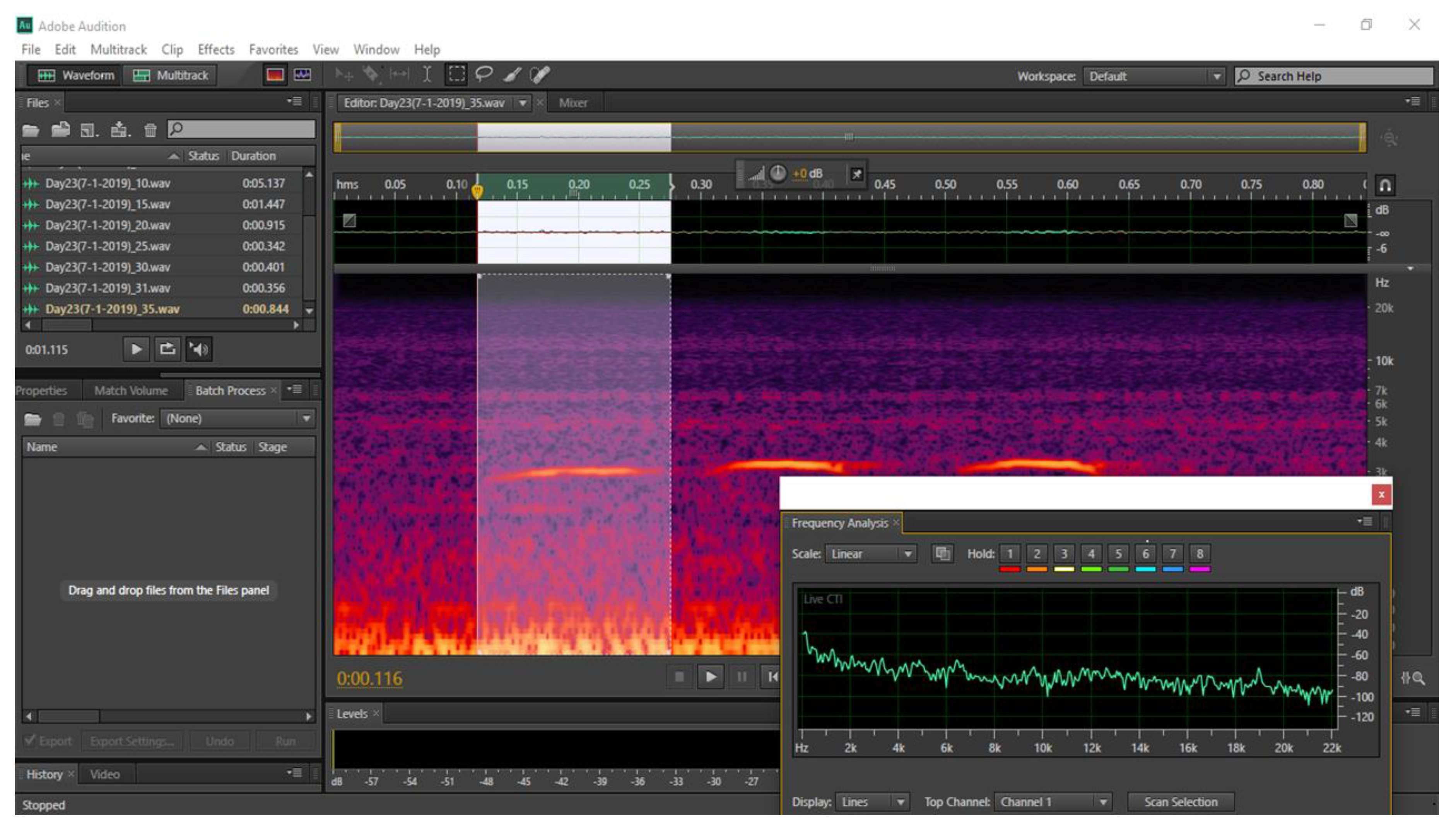
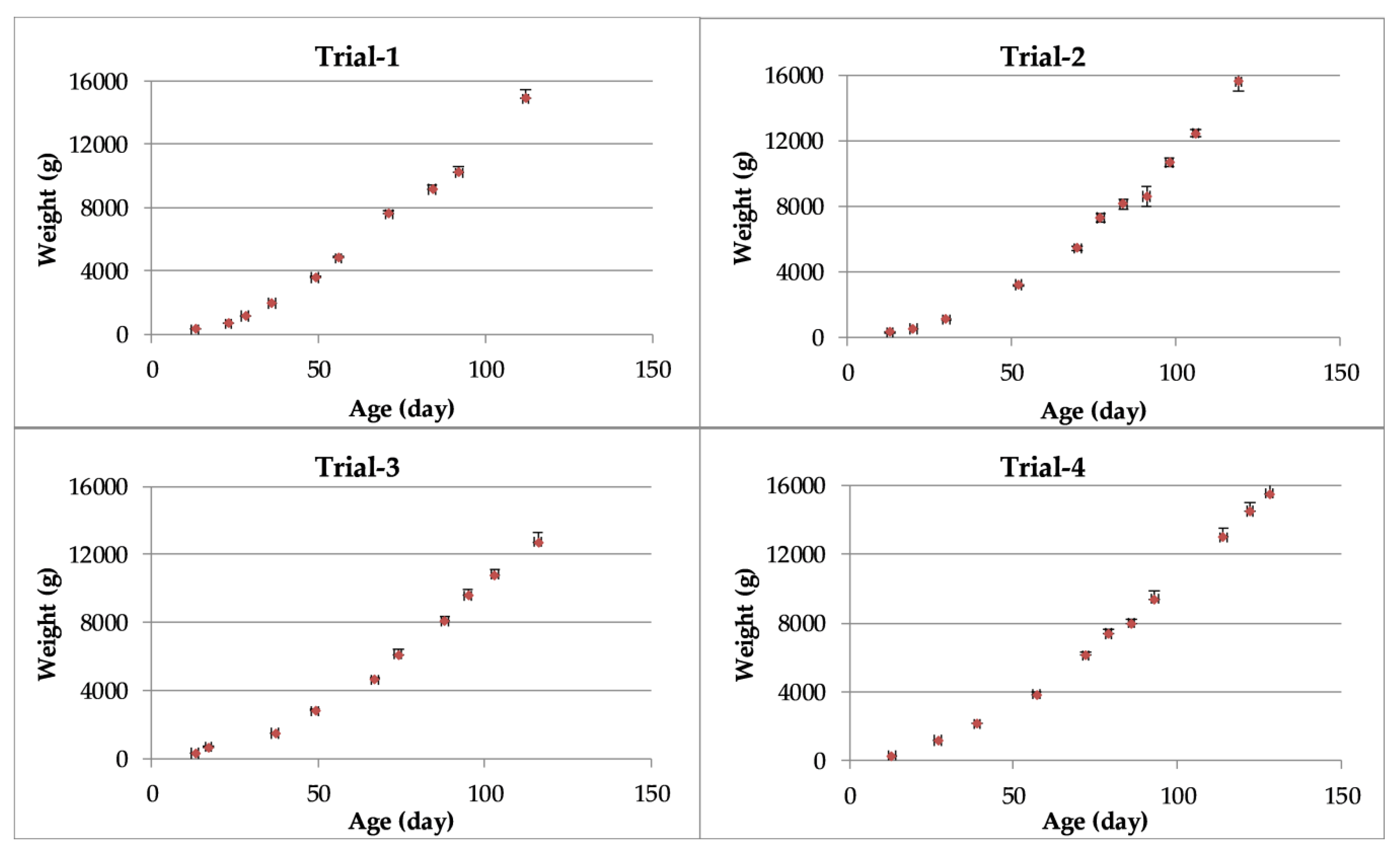
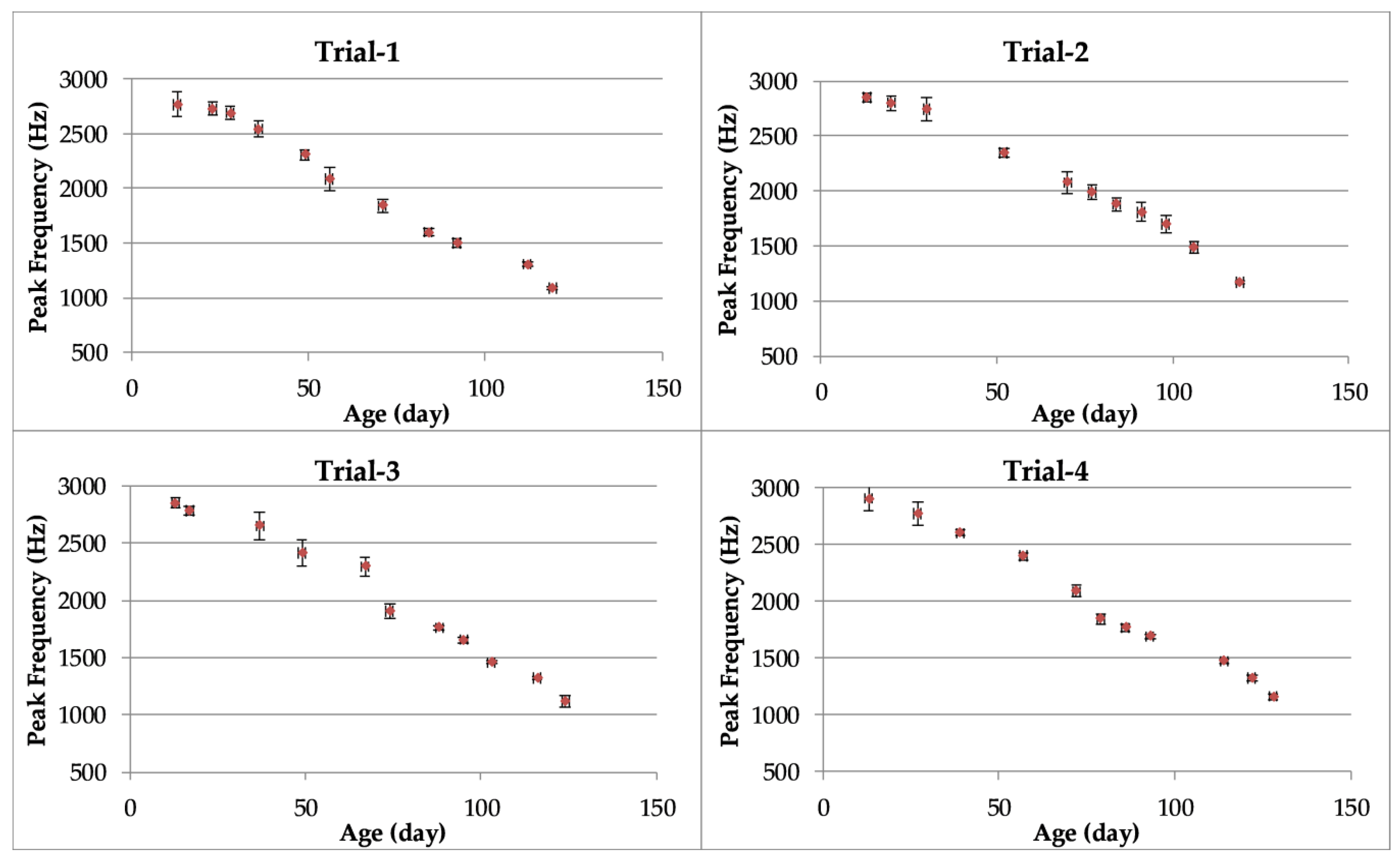

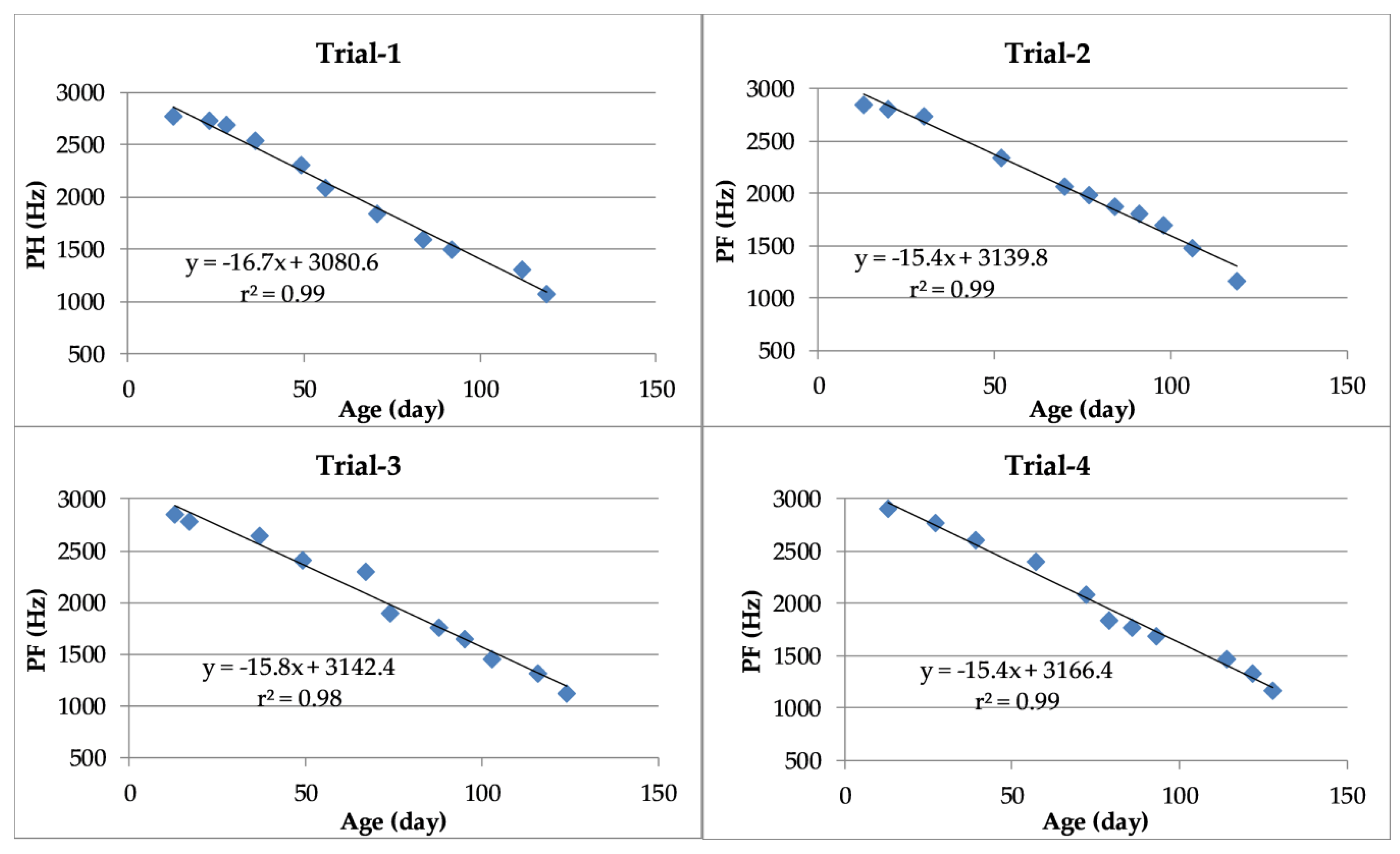
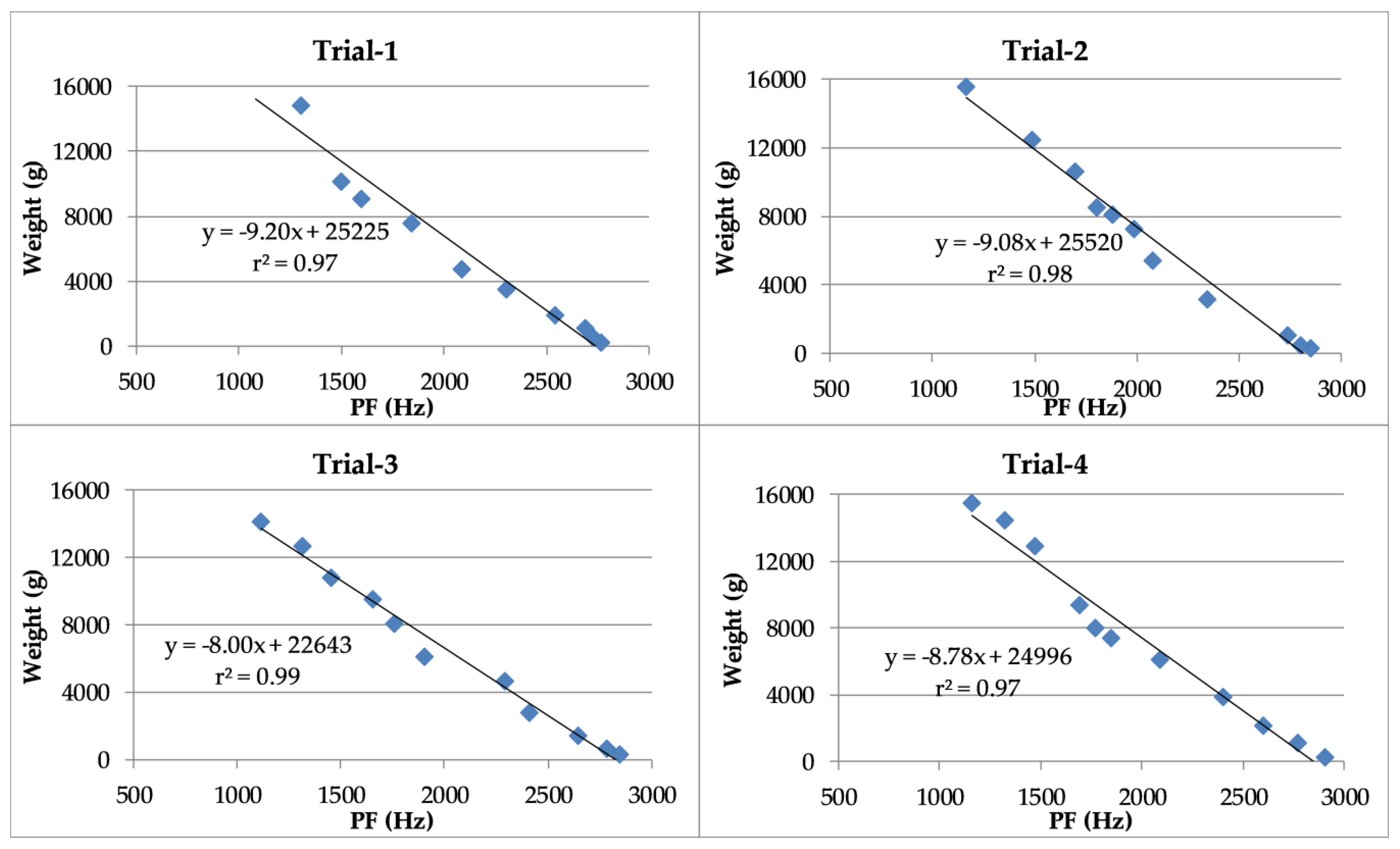
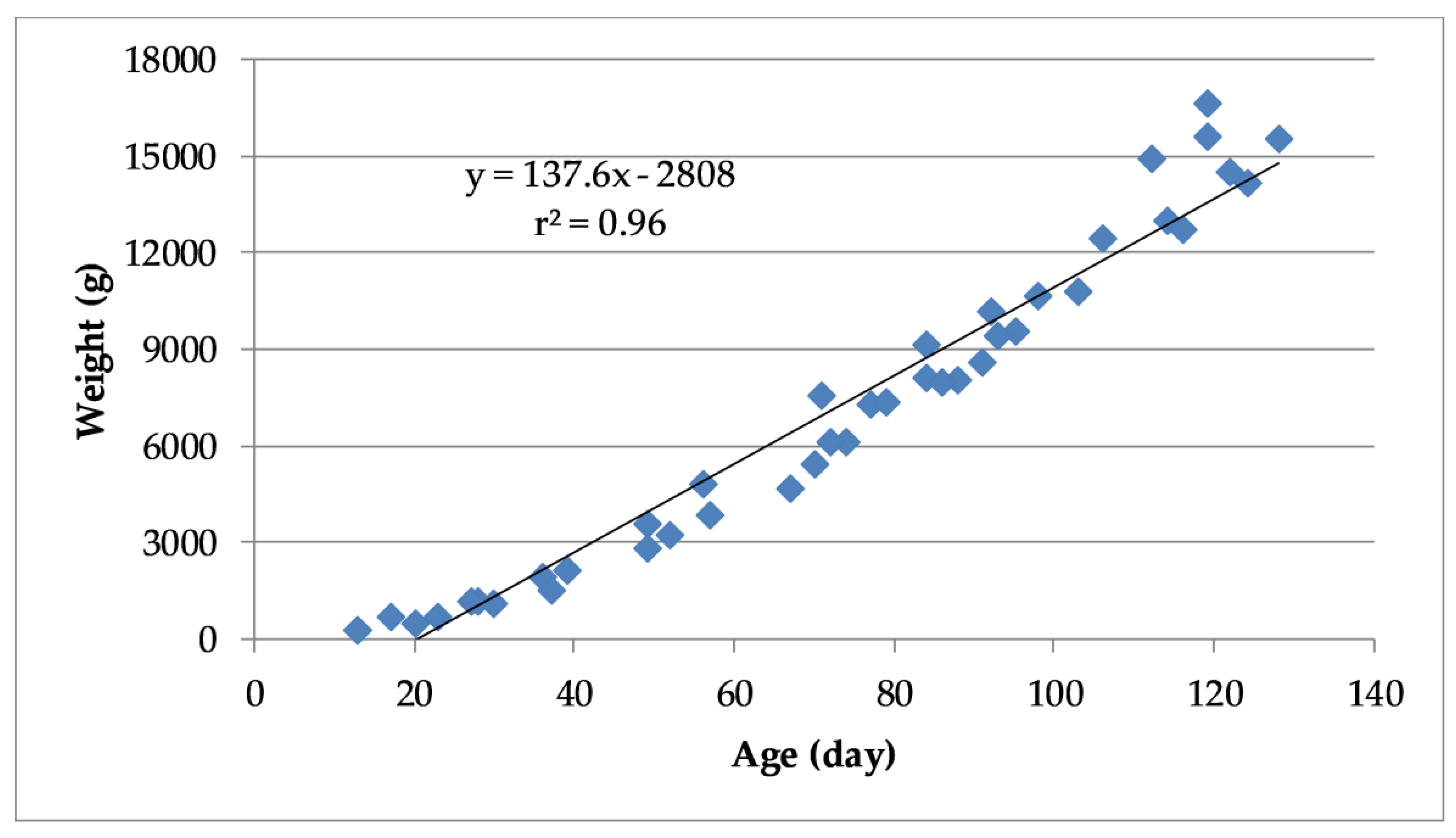
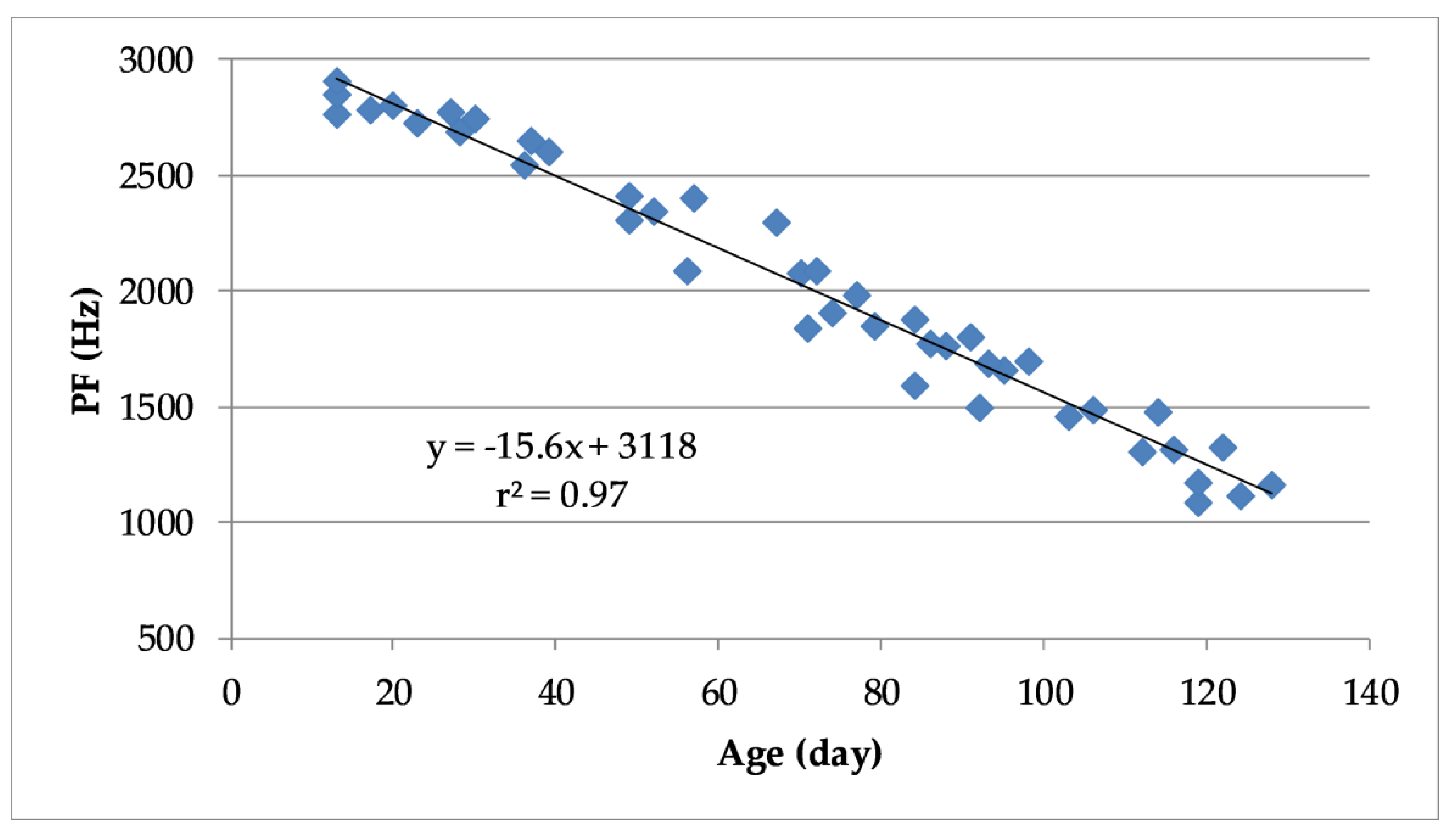
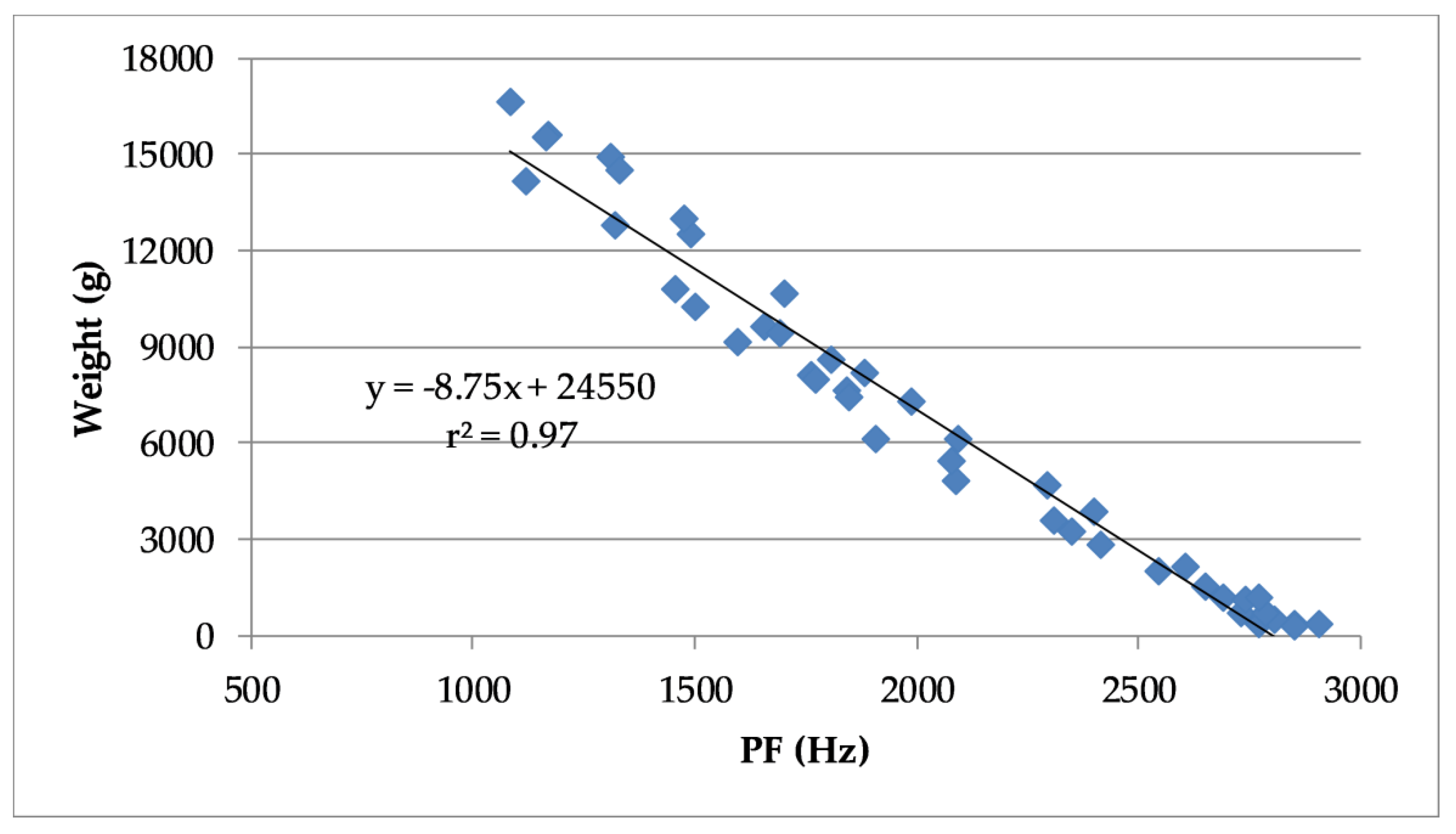
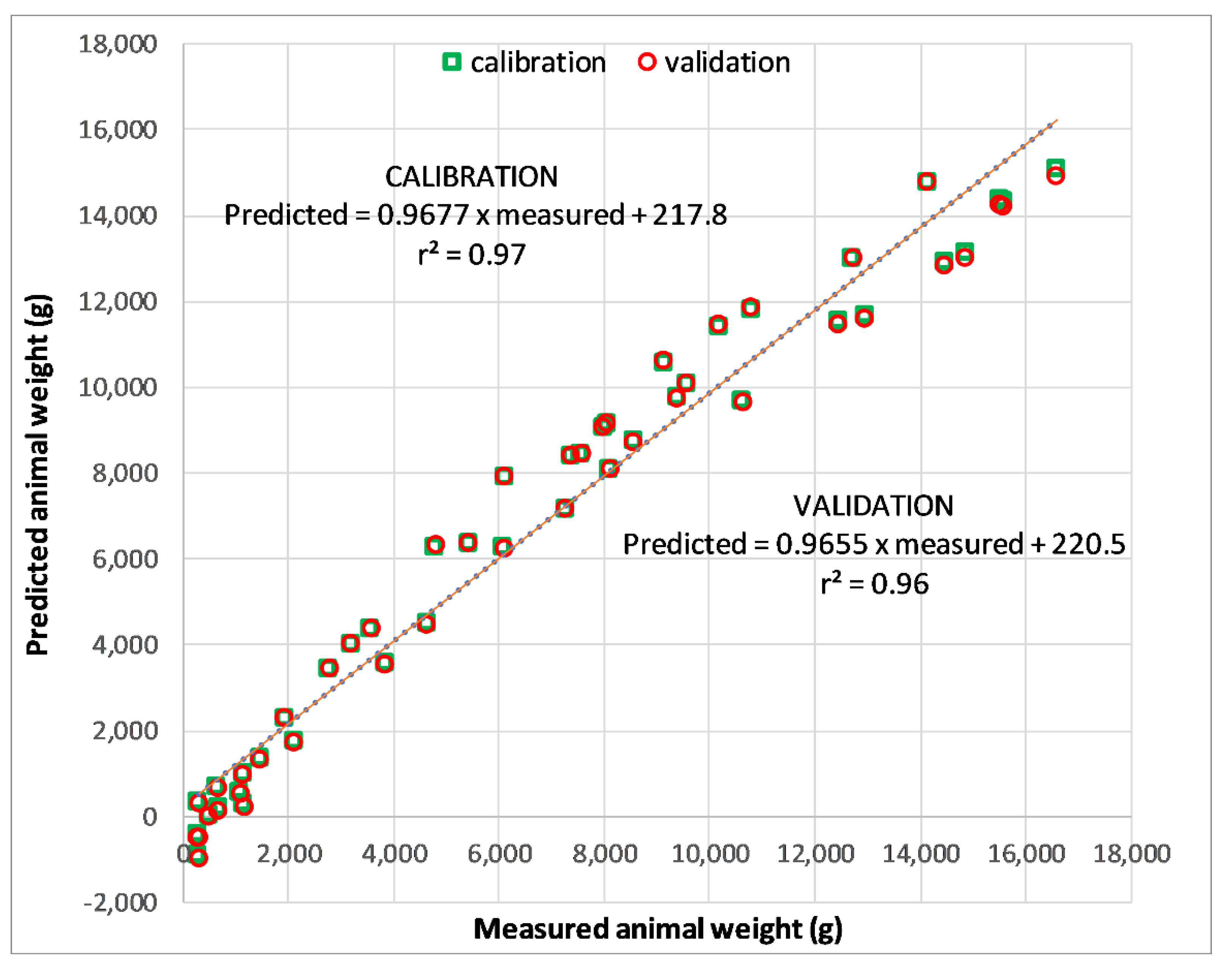
| Trial No. | Total No. of Birds | Day Numbers for Sound Recording and Bird Weighing | Duration, Days |
|---|---|---|---|
| 1 | 250 | 13, 23, 28, 36, 49, 56, 71, 84, 92, 112 and 119 | 13–119 |
| 2 | 120 | 13, 20, 30, 52, 70, 77, 84, 91, 98, 106 and 119 | 13–119 |
| 3 | 100 | 13, 17, 37, 49, 67, 74, 88, 95, 103, 116 and 124 | 13–124 |
| 4 | 100 | 13, 27, 39, 57, 72, 79, 86, 93, 114, 122 and 128 | 13–128 |
| Estimated Weight (G) Using Peak Frequency with the Four Regression Models | Evaluation Statistics | ||||||
|---|---|---|---|---|---|---|---|
| Models | Mean Observed | Mean Predicted | |||||
| Model | Trial-1 | r2 | b | NSE | RMSE | FB | |
| Trial-2 | 6517.8 | 6196.7 | 0.962 | 1.022 | 0.975 | 757.96 | −0.97 |
| Trial-3 | 6318.6 | 6597.0 | 0.933 | 1.272 | 0.866 | 1604.23 | −1.77 |
| Trial-4 | 7553.2 | 7925.2 | 0.984 | 1.190 | 0.943 | 928.60 | −0.06 |
| Model | Trial-2 | ||||||
| Trial-1 | 6534.5 | 6842.4 | 0.970 | 0.933 | 0.970 | 1010.391 | 0.085 |
| Trial-3 | 6318.6 | 6902.6 | 0.966 | 1.221 | 0.880 | 1507.981 | −1.184 |
| Trial-4 | 7553.2 | 7925.2 | 0.984 | 1.190 | 0.943 | 928.60 | −0.06 |
| Model | Trial-3 | ||||||
| Trial-1 | 6534.5 | 6815.4 | 0.943 | 0.739 | 0.913 | 1,626.33 | 0.75 |
| Trial-2 | 6517.8 | 6558.5 | 0.962 | 0.778 | 0.939 | 1,182.72 | 0.82 |
| Trial-4 | 7553.2 | 7874.4 | 0.984 | 0.906 | 0.979 | 584.48 | 0.13 |
| Model | Trial-4 | ||||||
| Trial-1 | 6534.5 | 6393.8 | 0.943 | 0.809 | 0.967 | 1312.14 | 0.23 |
| Trial-2 | 5609.6 | 5405.7 | 0.962 | 0.851 | 0.978 | 994.80 | −0.05 |
| Trial-3 | 6318.6 | 6446.1 | 0.933 | 1.060 | 0.981 | 913.08 | −0.71 |
| Estimated Weight (G) Using Peak Frequency (Equation (2)) | Evaluation Statistics | ||||||
|---|---|---|---|---|---|---|---|
| Trial no. | Mean Observed | Mean Predicted | r2 | b | NSE | RMSE | FB |
| Trial-1 | 6445.8 | 6692.6 | 0.966 | 0.918 | 0.961 | 1,073.978 | 0.079 |
| Trial-2 | 6656.4 | 6376.5 | 0.982 | 0.945 | 0.977 | 739.867 | −0.322 |
| Trial-3 | 6488.7 | 6891.1 | 0.986 | 1.078 | 0.970 | 810.424 | −0.208 |
| Trial-4 | 7393.7 | 7022.8 | 0.970 | 0.965 | 0.964 | 959.408 | −0.435 |
| Evaluation Statistics | Calibration | Validation |
|---|---|---|
| r2 | 0.97 | 0.96 |
| Slope | 0.967715 | 0.965523 |
| NSE | 0.968 | 0.964 |
| RMSE | 905.27 | 951.36 |
| FB | 0.002 | 0.179 |
© 2020 by the authors. Licensee MDPI, Basel, Switzerland. This article is an open access article distributed under the terms and conditions of the Creative Commons Attribution (CC BY) license (http://creativecommons.org/licenses/by/4.0/).
Share and Cite
Abdel-Kafy, E.-S.M.; Ibraheim, S.E.; Finzi, A.; Youssef, S.F.; Behiry, F.M.; Provolo, G. Sound Analysis to Predict the Growth of Turkeys. Animals 2020, 10, 866. https://doi.org/10.3390/ani10050866
Abdel-Kafy E-SM, Ibraheim SE, Finzi A, Youssef SF, Behiry FM, Provolo G. Sound Analysis to Predict the Growth of Turkeys. Animals. 2020; 10(5):866. https://doi.org/10.3390/ani10050866
Chicago/Turabian StyleAbdel-Kafy, El-Sayed M., Samya E. Ibraheim, Alberto Finzi, Sabbah F. Youssef, Fatma M. Behiry, and Giorgio Provolo. 2020. "Sound Analysis to Predict the Growth of Turkeys" Animals 10, no. 5: 866. https://doi.org/10.3390/ani10050866
APA StyleAbdel-Kafy, E.-S. M., Ibraheim, S. E., Finzi, A., Youssef, S. F., Behiry, F. M., & Provolo, G. (2020). Sound Analysis to Predict the Growth of Turkeys. Animals, 10(5), 866. https://doi.org/10.3390/ani10050866





